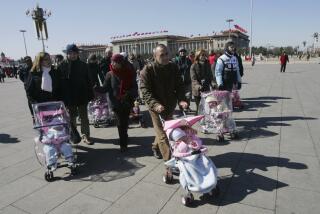Sex Bias in China Puts Girls in Jeopardy
SHANGHAI, China — Mrs. Liu could have had three daughters by now. But the shame and legal costs would have been unbearable, so she gave her second daughter away at birth and aborted a third when an ultrasound scan showed that fetus, too, was female.
In 1949, the Communist Party took power promising to end centuries of degradation for China’s women. Yet hundreds of thousands of unwanted baby girls are abandoned, aborted and even killed each year.
For poor, rural families, the choice is as stark as it is cruel. To keep a girl risks public ridicule in villages where traditions favoring boys still run strong.
Government limits on family sizes imposed since 1979 also mean that by keeping a girl, couples can lose their chance for a boy--long prized in China as the heir who will carry on the family name, till the family plot and care for his parents in old age.
“A woman without a son will be cursed by her mother-in-law and laughed at by the village,” says Liu, a farmer in the impoverished eastern province of Anhui. “Everybody thinks it’s the duty of a woman to bear a boy.”
Liu, 36, asks that her full name not be used for fear that village officials who enforce birth quotas might punish her if they learned of the daughter she gave away. Those quotas, aimed at slowing the growth of China’s population, now 1.26 billion, limit rural families to one child, or two if the first is a girl. A third would have brought Mrs. Liu heavy fines or maybe even a forced abortion.
So many baby girls are “missing” that shocked Chinese authorities have delayed releasing figures from a national census last year that showed the problem is getting worse.
Experts who have seen the results say they show almost 900,000 fewer girls were reported born last year than would be expected from natural birth rates. That’s up from a shortfall of about 500,000 in 1990.
Normally, women give birth to about 107 boys for every 100 girls. But in China, 118 boys were born last year for every 100 girls. The ratio is creeping up: In 1990, it was 112 boys per 100 girls.
The World Health Organization, in a 1997 report, estimated as many as 50 million Chinese girls are missing since the problem appeared in the early 1980s.
The births of many girls are simply not reported, Chinese experts say. Instead, parents give them to childless relatives or neighbors, or abandon them on the doorsteps of hospitals or government offices. Girls fill China’s 900 state-run orphanages.
The lopsided gender ratio, with far more males than females reaching marriage age, is creating social strains and helping to drive a thriving market for brides and prostitution. Rural men pay handsomely for a wife--even one abducted and married off against her will.
When the communists took power in 1949, they virtually eradicated the previously common practice of killing unwanted newborn girls. Officials plastered the countryside with slogans like “A girl is worth as much as a boy” and “Firmly uphold equal rights for girls and boys.”
But today, tradition and modern technology work hand in hand. Rising incomes in rural areas have made ultrasound scans affordable. And although laws ostensibly bar doctors from disclosing the sex of an unborn child, bribes can loosen their tongues.
Officials say couples pay as much as 500 yuan ($60)--10 times the cost of a regular checkup and more than many farmers earn in a month--to learn the sex of a fetus. Illegal abortions are readily available for those who don’t want a girl.
“Sex-selective abortions account for at least a third and maybe more than half of the missing girls,” said Zeng Yi, a population expert at Peking University.
For women in areas too remote or too poor for ultrasound, infanticide remains a last resort, according to a Chinese study released in January.
“Some parents consider female infanticide nothing more than a delayed abortion,” said one of the authors, Zhu Chuzhu of Jiaotong University in the northern city of Xi’an.
Chinese girls also are far more likely to die before age 5--a reversal of their natural propensity to survive boys, the study found. That’s because some parents see no point in spending time and money on a girl who will leave them to live with her husband when she marries. The study found rural parents less likely to take girls to the doctor or feed them as well as boys.
After years of trying, Liu finally had a boy in 1997. Her husband celebrated by getting drunk and buying her candy. “That night was like New Year’s Eve,” she says.
She dreams of sending her son to college and is saving for an expensive kindergarten near her village outside Anqing, a city 250 miles west of Shanghai.
She has no plans for her 9-year-old daughter beyond the nine years of compulsory education.
Still, her eyes redden when she recalls the winter night seven years ago when she let the midwife take away her second daughter.
“I only heard her cry once. I never even saw her face,” says Mrs. Liu, a slightly built woman with a face creased by years of working outside. “I cried and cried, missing her very much. But reality stopped me from trying to take her back. I had to have a boy.”
Relatives who took the child say she is alive and was adopted in a neighboring village, though they won’t tell her where.
“I dare not imagine that she might be dead,” Liu says.
*
On the Net:
China’s national census: https://www.stats.gov.cn/english/index.html
More to Read
Sign up for Essential California
The most important California stories and recommendations in your inbox every morning.
You may occasionally receive promotional content from the Los Angeles Times.










